
20 minute read
The Great Wave: How to Identify Reproductions
Capucine Korenberg
The Great Wave: How to Identify Reproductions
Advertisement
Capucine Korenberg
Katsushika Hokusai’s Under the Wave off Kanagawa (Kanagawa oki nami ura), more popularly known as The Great Wave, is undoubtedly the most iconic of all Japanese woodblock prints (fi g. 1). First published in 1831, it has since inspired generations of Japanese and non-Japanese artists, permeating popular culture worldwide from the nineteenth century to the present day (fi gs. 2 & 3). The design of The Great Wave has also been used in advertising campaigns for many brands, including Panasonic, Kikkoman and Perrier. Most recently, the Japanese manga artist Araki Hirohiko (b. 1960) designed The Sky above the Great Wave off the Coast of Kanagawa, one of the offi cial posters of the now postponed 2020 Tokyo Paralympics.1
1. (previous page)
Early original impression
of The Great Wave, c. 1830–
1832, colour woodblock
print, 25.4 × 38.1 cm,
published by Nishimura
Yohachi
The Metropolitan Museum, The Howard Mansfi eld Collection, Purchase, Rogers Fund, accession no. JP2569, CC0 1.0 Universal
2.
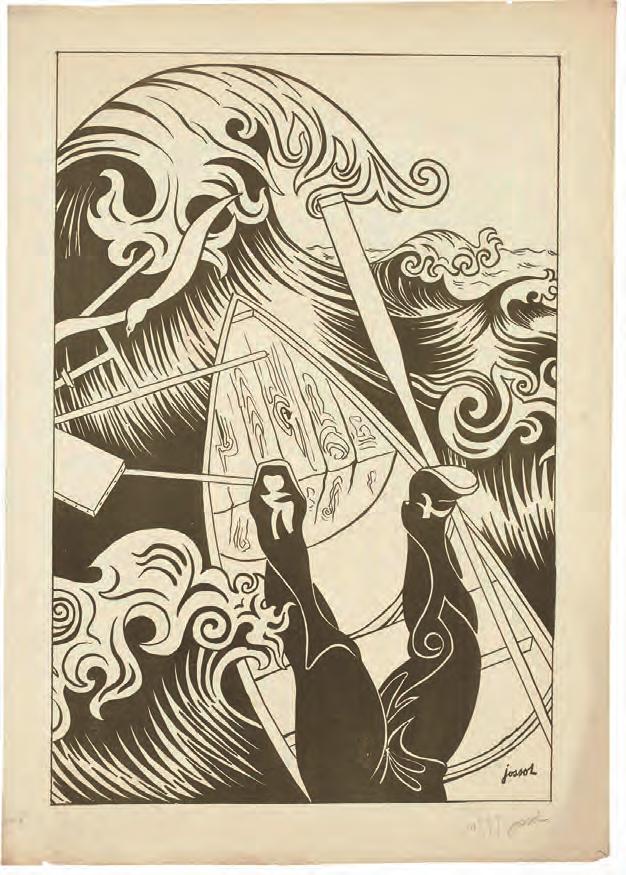
Henri Gustave Jossot
(1866–1951)
The Wave (La vague), 1894,
lithograph in green on
cream laid paper, 61 × 43 cm
Art Institute of Chicago, Joseph Brooks Fair and Frank B. Hubachek funds; Prints and Drawing Endowment Fund, accession no. 2019.140, CC0 1.0 Universal
During the Edo period (1603–1868), many woodblock prints were mass-produced, inexpensive items. In the 1830s, for instance, it was recorded that a woodblock print cost the same as about two bowls of noodles. The production of woodblock prints was a commercial business and designs were printed as long as there were customers willing to buy them. Experts estimate that Hokusai’s best-selling The Great Wave could have been printed up to 8,000 times using the original woodblocks.2 There are often variations in the colour palette and printing eff ects between diff erent printings of the same design. In my role as a museum scientist, I undertook a study over several months of the variations of The Great Wave from its fi rst to last surviving printings.3 This involved locating as many surviving impressions as possible in the collections of museums, galleries and libraries around the world. It should be noted that of the thousands of impressions of The Great Wave originally made only a fraction has survived to the present day. This is because commercial prints were considered ephemera, not objects of value, during the Edo period. Earthquakes and fi res, a frequent occurrence in Japan, also contributed to the loss of countless prints.
3.

Pejac
Everyone is an Artist (Tribute to Katsushika Hokusai), 2015, street mural in Kawasaki, Japan
© 2016 Pejac, Courtesy of the artist
Not surprisingly, many reproductions of this celebrated print exist. It was unexpected, however, to encounter several reproductions catalogued as originals in the collections of national and smaller or regional institutions. I also observed that reproductions of The Great Wave have been represented as originals in exhibitions and publications.4
Reproductions have never been systematically distinguished from the original impressions of The Great Wave and the question of whether an impression is original is of great interest to museum curators and enthusiasts of Japanese prints. As I came across more reproductions of The Great Wave and discussed my observations with colleagues and collectors of Japanese prints, I realised that the identifi cation of reproductions was not always straightforward. I pondered how useful it would be to fi nd ways to diff erentiate them from originals. After having examined more than one hundred original impressions of The Great Wave, I felt ready to meet this challenge.
The Making of Woodblock Prints
To better understand how to identify a reproduction, it might be instructive to describe briefl y how Japanese woodblock prints are produced. Using a set of carved woodblocks, the main outlines were printed using the ’key block’, which is block-cut with very fi ne ridges, while the coloured areas were produced with separate colour woodblocks. Typically, the outlines were printed fi rst, then the printer employed the fi rst colour woodblock, the second colour woodblock and so on.5 Up to eight woodblocks may have been used for The Great Wave. These are long lost but the key block of a modern reproduction is shown in fi gure 4. Reproductions were made from completely diff erent woodblocks than those employed for the original print. Woodblocks were block-cut manually and there were always variations between two woodblocks of the same design. Therefore, it should be possible to distinguish a reproduction by comparing the lines and the shapes of the solid areas with those in an original impression. Even if a woodblock was very accurately copied, variations should still be discernible in the intricately block-cut features, such as the outlines, the title or the signature, which were more challenging to cut.
A Closer Look at The Great Wave
Hokusai’s iconic work was printed with a limited colour palette. Although diff erent printings vary, the composition typically employs dark blue, medium blue and light blue for the sea; dark grey, light grey and yellow for the boats, Mount Fuji and the sky; and light brown for the clouds. Some of the pigments are light sensitive; the yellow and light-brown pigments have often faded. Infrequently, when an original print had very faded colours, replacement colours mimicking the originals were applied, but not always faithfully. Takamizawa Enji (1870–1927), who specialised in reproductions, was notorious for engaging highly skilled artisans to ‘revamp’ damaged ukiyo-e prints, sometimes washing out the old ink and carving new woodblocks to reprint areas with new ink. He then passed off the revamped prints as pristine original prints that fooled both print experts and collectors, including the American architect Frank Lloyd Wright (1867–1959).6 An example of a revamped impression of The Great Wave is housed in the collection of the Metropolitan Museum in New York.7 The outlines in that work match those of other originals but the forms of the clouds diverge. It is important to be aware of this practice in order to avoid the misidentifi cation of a revamped original impression as a reproduction.
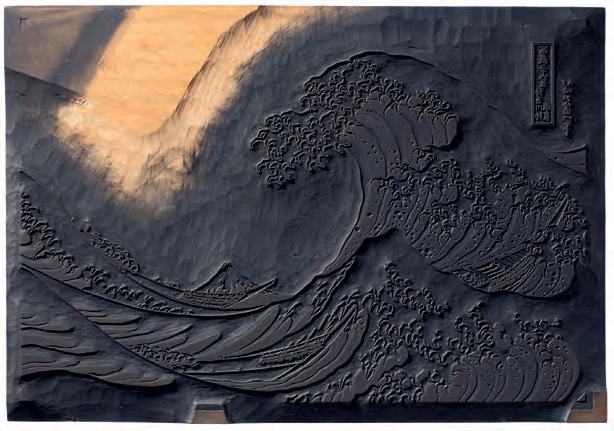
4. Key block of a modern reproduction of The Great Wave, 2017, block-cut by Suga Kayoko, Tokyo
The British Museum, accession no. 2017,3069.1 ©The Trustees of the British Museum
5a. 5b.


5a-b.
The light-blue areas in late
original impressions were
not printed with the same
woodblock as were early
original impressions.
(a) A late original
impression
Art Institute of Chicago, accession no. 1952.343, CC0 1.0 Universal
(b) An early original
impression
The British Museum, accession no. 2008,3008.1.JA ©The Trustees of the British Museum
The colour woodblocks for a design were sometimes replaced, most likely because they were damaged beyond use. The Great Wave is no exception. At some point, the woodblock for the light-blue shapes in the sea, as well as the woodblocks for the yellow and grey areas in the boats, were recut without changes in the blocks for the medium blue/dark blue/light brown or the key block.8 This is seen in the light-blue forms in the sea (fi g. 5a–b). Again, one should be aware of the existence of these new colour woodblocks for The Great Wave so as not to read an original impression as a reproduction.
Identifying Reproductions
In my study, I determined reproductions through a close examination of the details printed from the key block, including the straw mats in the boats or the ‘claws’ of the waves. This was a lengthy process. Once I had ascertained which works were reproductions, I sought a more expediate method to diff erentiate them from originals. In all of the original impressions of The Great Wave analysed, I noticed a small darkblue shape in a spot of sea foam (fi g. 6a–b). According to David Bull, an experienced ukiyo-e style block-cutter and printer based in Tokyo, this most likely corresponds to a sliver of wood that the block-cutter did not remove during the block-cutting of the original woodblock.9 I observed that this small imperfection was absent in each of the reproductions under examination. A high-resolution photograph would have been required, however, to detect this small imperfection. I then discovered another way to identify nearly all reproductions without a high-resolution photograph. When I studied how The Great Wave was made, I noticed that the darkest shapes in the sea had been printed in two steps: they were fi rst printed with the same ink used for the outlines, the cartouche and the signature (typically dark grey-blue) and next with medium-blue ink, or the other way round as it is diffi cult to verify which ink was applied fi rst. These two successive printings were done with separate
6a-b.
(a) A small imperfection
is visible on all high-
resolution images of
original impressions of The Great Wave; (b) location of
this small imperfection
British Museum, accession no. 2008,3008.1.JA ©The Trustees of the British Museum
7a–b.
(a) In the original
impressions, small shapes
in the sea are printed in
the same colour as the
outlines, here black, with
no overprinting of medium
blue
Harvard Art Museums/Arthur M. Sackler Museum, Gift of Dr Denman W. Ross, accession no. 1916.685, CC0 1.0 Universal
(b) These shapes are
printed in a lighter blue in
reproductions
Library of Congress, 02018u, CC0 1.0 Universal
6a.
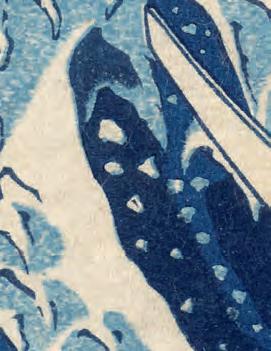
7a.
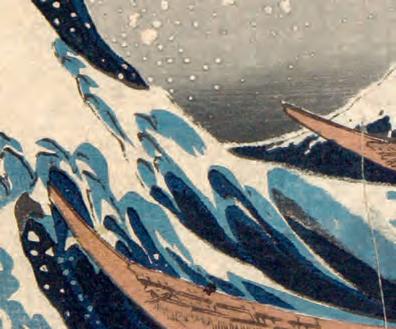
woodblocks – the key block and the mediumblue woodblock. Interestingly, there are four dark shapes in the sea in the centre of the design that were printed with only the key block, with no overprinting of medium blue. This indicates that these four shapes were not block-cut in the medium-blue woodblock, unlike all the other dark shapes of the sea. The absence of medium-blue overprinting in these areas is particularly striking in late impressions of the originals, in which black instead of dark-blue ink was utilised for the outlines (fi g. 7a–b). It is not clear whether the absence of these shapes in the medium-blue woodblock was intentional or was a mistake made by the block-cutter. Nevertheless, I noticed that in all the reproductions these specifi c areas were not printed in the same colour as the outlines, except in one type of reproduction. This showed that, unlike the
6b.

7b.
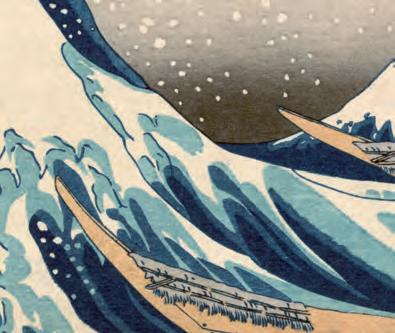
original impressions, these areas were printed with another woodblock – either medium or light blue (see fi g. 7b). It also came to my attention that some of the early reproductions (late nineteenth to mid-twentieth century) using the same set of reproduction woodblocks have survived in more than one impression. (This study excludes modern reproductions that exist in very large numbers of impressions. Printings from some of these contemporary block sets continue today.) I have identifi ed eight types in total, all dating to before 1950.10
Compare this with Hokusai’s series A Tour of Waterfalls in Various Provinces (1836), released after The Great Wave, for which only two types of reproductions are known.11 In an eff ort to distinguish reproductions from the original version of The Great Wave, I looked for the most salient diff erences, consulted
and compared the records of the institutions holding reproductions and, where possible, sought out the name of the publisher and the earliest known date of production for each type. These points are outlined in the following tables.
Type 1 (fi gs. 8a–d)
Characteristics
(1) Diff erent cloud shape* (2) Short strokes for the straw in the grey mats in the distant boat omitted
Earliest Acquisition**
Victoria and Albert Museum, 1922 (bequest of Thomas H. Lee)
* The cloud is not visible in several reproductions because the colour of the sky has faded. **The dates in this category are based on the forty-eight reproduction impressions examined for this study. It is possible that an impression entered the collection of another institution earlier. I surveyed the collection databases of approximately 120 institutions to discover whether they house reproductions of The Great Wave.
8a. 8b.

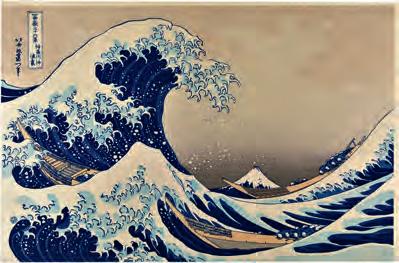
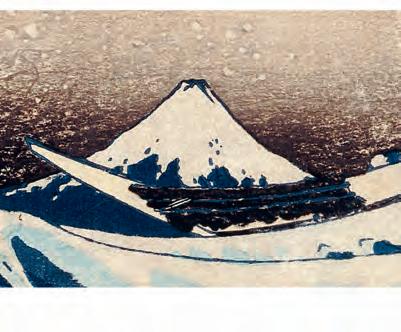
8c. 8d. Collections
Victoria and Albert Museum (London); Georgia Museum of Art (Athens, US); National Museum Krakow; Dunedin Public Art Gallery (New Zealand)

8a–d.
Type 1 Reproductions
(a) Full view; (b) straw mat
on the boat
Victoria & Albert Museum, accession no. E.1311-1922 ©Victoria and Albert Museum, London
(c) Short strokes show the
texture of the straw mat in
an original impression
Harvard Art Museums, accession no. 1916.685, CC0 1.0 Universal
(d) They are obscured by
the dark-grey colour used
to print the mat in some
late original impressions
The British Museum, accession no. 1906,1220,0.533 ©The Trustees of the British Museum
It is likely that the Type 1
Reproductions were copied
from such impressions.
Type 2 (fi gs. 9a–c)
Characteristics
(1) Diff erent cloud shape* (2) Diff erent toothed ends of the dark-blue wave recesses in the bottom left-hand side corner (3) Unevenness in the line of the wave on the right-hand side
9a.
Type 3 (fi gs. 10a–c, 11a–c)
Characteristics
(1) Diff erent light-blue shape in the bottom left-hand corner (2) Rather faithful reproductions; even the breaks in the lines caused by woodblock wear have been reproduced (3) Copied from late impressions printed using a replacement woodblock for light-blue areas
Earliest Acquisition
(1) Staatliche Kunstsammlungen Dresden, 1898 (2) Victoria and Albert Museum, 1915 (among tools and materials demonstrating Japanese printing acquired from Miyata
* The cloud is not visible in several reproductions because the colour of the sky has faded.
** Donated by Miyata Rokuzaemon on behalf of Yamawaki (H.), the Commissioner General of His Imperial Majesty’s Commission to the Panama International Exposition.12
Rokuzaemon)** 9b.


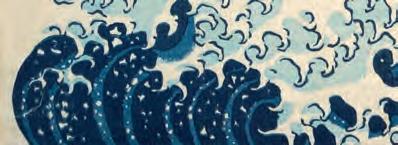
9c.
Publication date
According to the database of the Library of Congress, these prints were produced by Adachi before 1940; the Adachi publishing fi rm was established in 1926,* suggesting that these prints were probably published between 1926 and 1940
* The Adachi publishing fi rm, founded by Adachi Toyohisa (1902–1982),13 is still in operation and specialises in fi ne reproductions of ukiyo-e prints.
Collections
Victoria and Albert Museum (London); Chazen Museum of Art (Madison, Wisconsin); Staatliche Kunstsammlungen Dresden; John J. Burns Library Boston College; National Gallery Prague
9a–c.
Type 2 Reproductions
(a) Full view; (b) dark-
blue wave recesses in
the reproduction with
enhanced contrast to
better show their toothed
ends
Victoria and Albert Museum, accession no. E210.1915 ©Victoria and Albert Museum, London
(c) Dark-blue wave
recesses in an original
impression
Metropolitan Museum of Art, accession no. JP 2569, CC0 1.0 Universal
Collections
Library of Congress (Washington, DC); Museum Rietberg Zurich
Type 3 Reproductions
10a–c.
(a) Full view 10a. 10b.

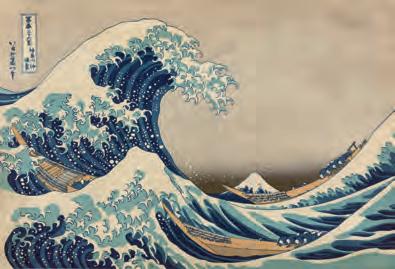
(b) Light-blue shape in the
bottom left corner
Library of Congress, Library of Congress control no 2008660568, CC0 1.0 Universal
10c.
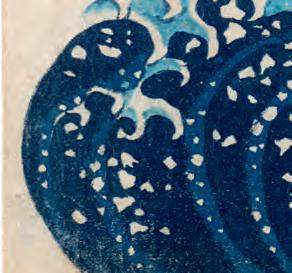
(c) This light-blue shape is
absent in original impressions
Metropolitan Museum of Art, accession no. JP 2569, CC0 1.0 Universal
11a–c.
(a) The block-cutter has
omitted some lines in the
sea in Type 3 Reproductions
Library of Congress, Library of Congress control no 2008660568, CC0 1.0 Universal
Type 4 (fi g. 12a–c)
(b) The absence of lines in
late original impressions of
The Great Wave was caused
by woodblock wear
Harvard Art Museums/Arthur M. Sackler Museum, Gift of Dr Denman W. Ross, accession no. 1916.685, CC0 1.0 Universal
(c) Compare with an early
original impression
Metropolitan Museum of Art, accession no. JP 2569, CC0 1.0 Universal
Characteristics
(1) Diff erent light-blue shapes in the sea, particularly in the right-hand corner (2) Copied from late impressions printed using a replacement woodblock for light-blue areas
Earliest Acquisition
Library of Congress, 1938; its database indicates that these prints were produced by Takamizawa after 1890*
*The Takamizawa publishing fi rm, founded in the late 1910s, is still in operation and
specialises in fi ne reproductions of ukiyo-e prints.14
Collections
Library of Congress (Washington, DC); Centre Céramique Maastricht; Museo Nazionale d’Arte Orientale ‘Giuseppe Tucci’ (Rome)
12a.
12a–c. Type 4 Reproduc ons
(a) Full view; (b) detail of the light-blue shapes
Library of Congress, Library of Congress control no 2008661021, CC0 1.0 Universal
(c) Compare with the blue shapes of an original impression
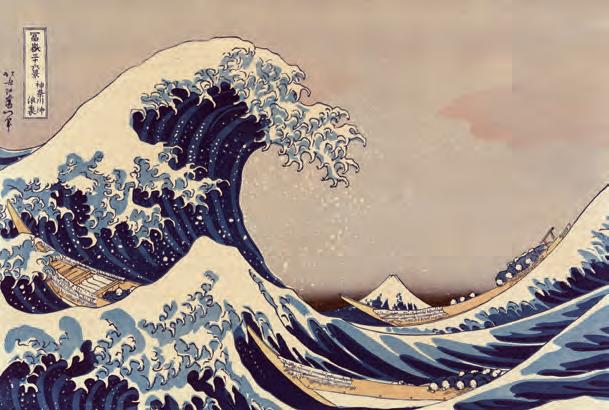
Harvard Art Museums/Arthur M. Sackler Museum, Gi of Dr. Denman W. Ross, accession no. 1916.685, CC0 1.0 Universal
Type 5 (fi g. 13)
Characteristics
(1) Diff erent cloud shape* (2) Diff erent straw mats in distant boat (3) Light-blue shapes in the sea have uneven edges, which are smooth in originals
Earliest Acquisition
Museo Nacional de Artes Decorativas (Madrid), 1916
* In several reproductions the cloud is not visible because the colour of the sky has faded.
12b.
12c.
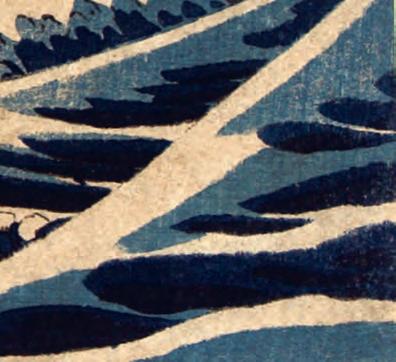
Collections
Blackburn Museum and Art Gallery (UK); l’École Française d’Extrême- Orient (Paris); Museo Nacional de Artes Decorativas (Madrid); Museu Nacional d'Art de Catalunya (Barcelona); Dunedin Public Art Gallery (New Zealand)
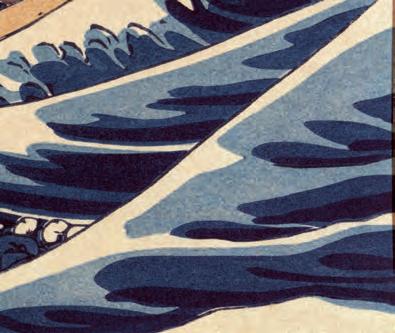
13.
Type 5 Reproductions
Blackburn Museum and Art Gallery, accession no. LC1024 © Blackburn Museum and Art Gallery
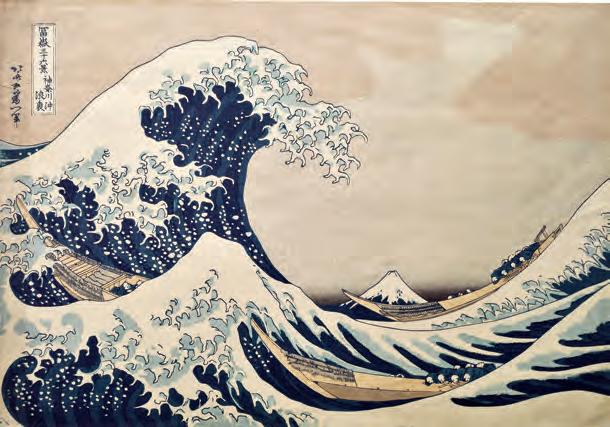
Type 6 (fi g. 14)
Characteristics*
(1) Finger-like shape pointing downwards out of the cloud (2) Light-grey stubble on the heads of the fi shermen
Earliest Acquisition
Pushkin Museum, 1948
* Very similar reproductions are still made by Fukui Asahido Co, Ltd. in Tokyo. ** Most of the collection of the Museu Nacional de Belas Artes was tragically destroyed in a fi re in 2018; it is unknown whether this print survived.
14.
Type 6 Reproductions
Pushkin Museum of Fine Arts, accession no. A-32302 © Pushkin Museum of Fine Arts
Collections
Pushkin Museum (Moscow); Museu Nacional de Belas Artes (Rio de Janeiro)**
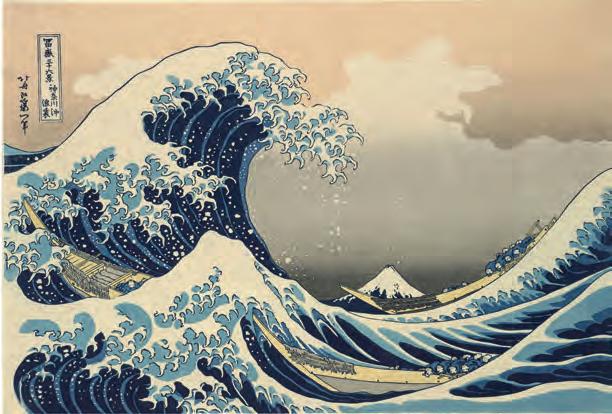
Type 7 (fi g. 15a–b)
Characteristics*
(1) Slightly diff erent shapes of the light-blue areas in the sea (2) Copied from rather early impressions Type 8 (fi g. 16a–b)
Characteristics*
(1) These prints have the ivy-leaf shaped seal of Kobayashi Bunshichi (1862–1923) (2) The key-block lines are reproduced with a very high degree of accuracy
Earliest Acquisition
Archives départementales des Hautes-Alpes (Gap, France), 1937
15a–b. Earliest Acquisition
The seal on the prints were used by Kobayashi Bunshichi, indicating a date of 1923 or earlier15
Collections
Harvard Art Museums (Cambridge, US) ; Archives départementales des
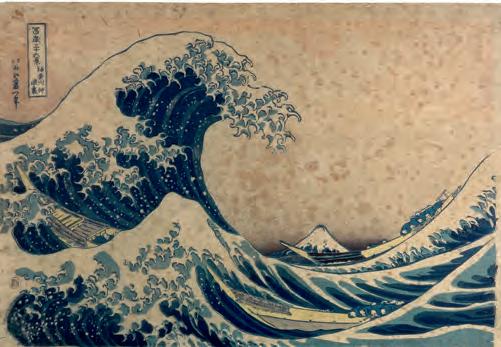
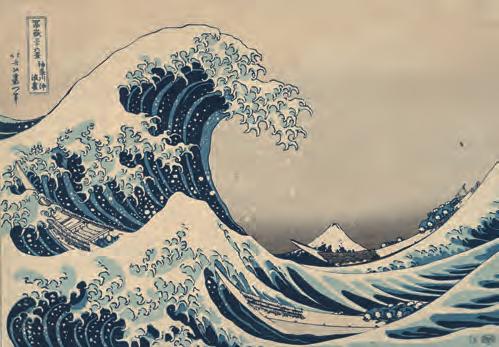
Type 7 Reproductions
(a) Full view; the light-
blue shapes in the sea are
diff erent from those in
original impressions
Harvard Art Museums/Arthur M. Sackler Museum, Gift of Robert Gregg Stone, accession no. 1949.146.24, CC0 1.0 Universal
Hautes-Alpes (Gap, France)
(b) Compare with the
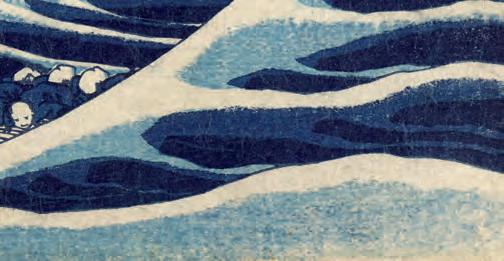
light-blue shapes in
the bottom right-
hand side corner in an
original impression
The British Museum, accession no. 2008,3008.1.JA © The Trustees of the British Museum
Collections
Free Library of Philadelphia; Bibliothèque nationale de France (Paris); Baltimore Museum of Art
16a-b.
Type 8 Reproductions
(a) Full view; (b) detail of
the Kobayashi Bunshichi
seal
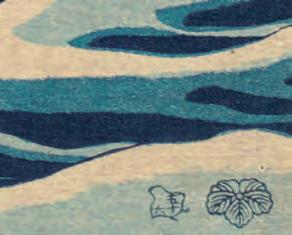
Free Library of Philadelphia, item no. facjp00066, CC0 1.0 Universal
Concluding Remarks
A detailed examination of the originals and reproductions of The Great Wave has led to the discovery of specifi c features present in originals but absent in reproductions. An identifi cation of these features should enable us to distinguish between original prints and reproductions. I also noticed similarities between several reproductions, making it clear that they had been printed with the same set of reproduction woodblocks. For each of the eight reproduction types noted, I have highlighted characteristic diff erences from the original print in order to provide a defi nitive comparison that will hopefully assist scholars, collectors and art lovers in drawing distinctions between original impressions and reproductions, and to address the current confusion regarding extant impressions. The considerable number of reproduction types refl ects the great demand for representations of The Great Wave and highlights its importance in popular culture. NOTES
1 The event is postponed until August 2021 due to the Covid-19 pandemic. This poster can be viewed online,https://gtimg.tokyo2020.org/image/upload/production/ ilgqpb15ks0oninsx7uf.pdf, accessed 24 August 2020.
2 Timothy Clark, ed., Hokusai: Beyond the Great Wave, Thames & Hudson Ltd., London, 2017, 109.
3 Capucine Korenberg, ‘The Making and Evolution of Hokusai’s Great Wave’, in Timothy Clark and Angus Lockyer, Late Hokusai: Thought, Technique, Society, British Museum Press, London, 2021 (forthcoming). A summary of this work can be found online at https:// blog.britishmuseum.org/the-great-wave-spot-the-diff erence/, accessed 15 July 2020. In the present article, the term ‘impression’ refers to one of a number of printings of the same design made at diff erent times from the same set of woodblocks (or at least the same key block). A ‘reproduction’ is an impression made from a completely diff erent set of woodblocks. The results presented in this article are entirely my own; I accept responsibility for any errors or oversights.
4 The two Great Wave prints displayed (rotated to limit their exposure to light) as originals in the 2018–2019 exhibition Montagne et paysage dans l’estampe japonaise at the Musée de l'Ancien Evêché in Grenoble, France, were reproductions: one belonged to l’École Française d’Extrême-Orient and the other was from the Archives départementales des Hautes-Alpes (accession no. 1140/16). The print in fi gure 23.1 in David Bell, Hokusai and Fuji: Cognition, Convention and Pictorial Invention in Japanese Pictorial Arts, in The Cambridge Handbook of the Psychology of Aesthetics and the Arts, Cambridge Handbooks in Psychology, edited by Pablo P.L. Tinio, Jeff rey K. Smith, Cambridge University Press, Cambridge, 2014, 563, is a reproduction of The Great Wave. The illustration for The Great Wave in the e-book, Peter Russell, Delphi Collected Works of Katsushika Hokusai, Delphi Publishing, Hastings, 2019, is also a reproduction.
5 A demonstration on how the woodblocks were block-cut and then used to produce The Great Wave can be viewed online at https://youtu.be/TeLmx1-1rz4, accessed 15 July 2020.
6 Julia Meech, Frank Lloyd Wright and the Art of Japan: The Architect's Other Passion, Harry N. Abrams, New York, 2000, 142–50.
7 A photograph of this impression (accession no. JP2972) can be seen online at https:// www.metmuseum.org/art/collection/search/56353, accessed 15 July 2020.
8 Korenberg, ‘The Making and Evolution of Hokusai’s Great Wave’.
9 David Bull, The Great Wave – Part 15 video, https://mokuhankan.com/hokusai/videos. php, accessed 15 July 2020.
10 I have opted for the term ‘type’ over ‘state’ here since the latter is typically used to distinguish between impressions made from the original set of woodblocks versus subsequent sets, either those made with added or omitted blocks or, as in the case of the reproductions in the present article, those made from completely recut sets of blocks. ‘Type’ therefore refers to the various sets of entirely recut blocks used to make the eight variants of reproduction prints discussed here.
11 Roger Keyes and Peter Morse, ‘Hokusai’s Waterfalls and a Set of Copies’, Oriental Art vol. XVIII, no. 2 (Summer 1972): 141–47.
12 Edward F. Strange, Tools and Materials Illustrating the Japanese Method of Colour-Printing; A Descriptive Catalogue of a Collection Exhibited in the Museum, Victoria & Albert Museum Department of Engraving, Illustration and Design, London, 1924.
13 Helen Merritt and Nanako Yamada, Guide to Modern Japanese Woodblock Prints: 1900–1975, University of Hawai‘i Press, Honolulu, 1992, 215.
14 Merritt and Yamada, Guide to Modern Japanese Woodblock Prints, 219.
15 Merritt and Yamada, Guide to Modern Japanese Woodblock Prints, 217.


